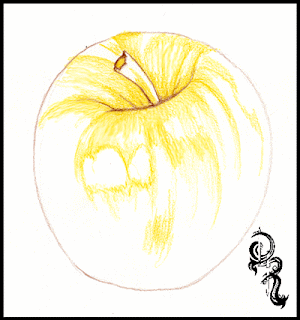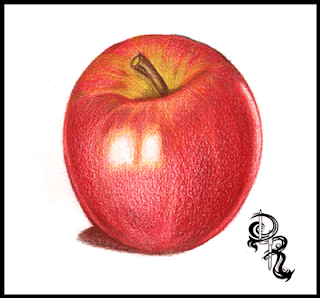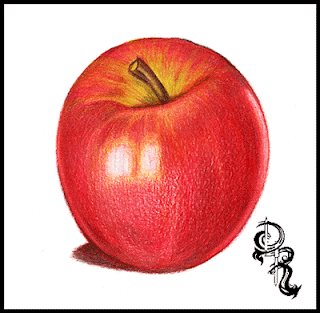How to Color a Delicious Pink Lady Apple
by Derrick Rathgeber
RoseArt Colored Pencils we will be using.
·
White
·
Golden Yellow
·
True Orange
·
Bronze Yellow
·
Celery
·
Cardinal Red
·
Cherry Red
·
Raspberry
·
Brown
·
Black
Welcome to the great drawing lessons here on Derrick the Artist. Today I will be teaching you how to color your very own delicious pink lady
apple. In this exercise I will give you tips on how to over lay colors, blend
them to create lights and shadows, as well as textures. So let’s get started shall we.
Step 1: If
you are comfortable with your drawing skills start off your picture by drawing
the apple shape below with the brown colored pencil. Remember your apple does
not have to be a perfect shape because no apple is a perfect sphere.
Tips: A PDF
version is available if you would like to skip this step and go right into the
coloring. Download the printable version by clicking the link below:
Step 2: Using
the Golden
Yellow make dark to light strokes outlining the shine. Start at the
base of the step and define the shape of the apple. This color will act as the
base and guide for the rest of the colors to come. Next use the Bronze
Yellow and darken the yellow areas on the stem and the area around the
stem. This will help blend into the green Celery color in the next step.
Tips: Use more pressure on the pencil at the edges and around the shine areas, then slowly raise the pencil up decreasing the pressure of the pencil.
Step 3: Using
the Celery
color you will go over the Golden Yellow color on the top of
the apple. Start from the base of the stem and create line in arcs to the rim
of the apple, then fill them in with the Celery green covering a good area of
the top, but leave some areas available for the red to come through. Also add
some Celery
color to the stem as well.
Step 4:
Now it’s time to set the base for rest of the apple. Using the True
Orange we will start from the stem base and color the apple almost like
a pumpkin. Fill in the top half of the
apple leaving small empty spaces along the edge, and along the base of the
bottom. Keep a white strip-like area empty along the right side of the apple, as
this will act as a reflective shine making the apple look more realistic.
Tips: References are great. If you have an apple
at home shine a light on it to see how light shines and reflects on it so you
can replicate this effect in your drawing.
Step 5: It’s
time to watch your apple come to life. Use the Cardinal Red and cover
the apple in nice even strokes with the apple from top to bottom and at a
curve. Remember to leave the large shine in the center, and on the right clear.
I like to rotate the paper so I can keep my hand still and move only the pencil
across the paper. Once the apple is covered evenly begin adding pressure and
coloring in areas darker near the edges and the top of the apple. Leave the
area near the large shine lightened as shown in the picture.
Tips: Try to keep your pencil stokes in one
direction. In this case arc them downward creating the illusion of a round
object. After you have covered the area
you can crosshatch to darken areas of the drawing.
Step 6: The candy apple read that makes you drool. That’s
what we are going for. So let’s add the next layer of red. This time we are
using Cherry Red to help fill in gaps, smooth out our fruit, and
generate a one of a kind look. Starting at the borders of the apple we are
going to go over the Cardinal Red and start coloring
towards the shine lightening our strokes along the way. Also get the top of the
apple, and overlay the red partially over the yellows and greens to pull it all
together. When you are satisfied with the look of your apple, move on to the
next layer of red in the next step. Yep that’s right Three layers of red.
Step 7: This
is the last layer of red I promise. Grab the Raspberry Red colored
pencil and use heavy pressure along the areas you want to add shadows to. You
can use the image as reference or use your gut. Get the areas close to the
edges, and highlight the shine on the top near the stem. At this point your
apple will have a realistic shine and reflect the paper it is drawn on. As an
option also use this color to create a shadow on the floor. Remember where your
light is coming from and color your shadow based on that. In this case I have
light coming from the rear and the front so the shadow is outlined as shown.
Tips: If your drawing doesn’t look like the image
shown do not worry. If I were to draw this again mine would look different too.
Remember to enjoy yourself and take your time.
Step 8: Time to give your apple an earthy look,
and finally give that stem some color. Reach for the Brown and fill in the
stem from base to top leaving some green color. Remember to color with the stem
shape, and for an extra measure of realism sketch some harder lines. Next add a
layer of brown across the entire apple, and the shadow. Remember to leave the
shines white. Adjust your pressure to the level that you want. This gives the
apple some more texture, and colors to capture the eye.
Tip: If you would like to color the apple with
other colors you can use these techniques with most fruit and objects. Simple
adjust your color palette, and have fun.
Step 9: We
are now heading to the final touch ups. Get a hold of the Black pencil and we
will finalize the shadows. Start off by
coloring over the shadow on the ground. Once you are finished start darkening
the left side using the shines as a guide to stop. On the right side of the
apple you will start from the white strip and go from heavy pressure to light
pressure as you meet in the middle. Then add some dark areas in the stem to
show that the apple dips in. Once you are satisfied with your look we will move
on to the final step.
Tips: Black is your friend. With colored pencils
you can cover other colors without making over shadowing them completely. If
you need to go darker simply add another layer.
Step 10:
And we are at the finish line! This step is probably one that most people don’t
see coming. Go ahead and take the white pencil, and start coloring over the
entire apple. You will notice that as you color the colors will not only
lighten up but they will blend together and smoothen out. This is probably one
of the greatest kept secrets, and now you know. The white colored pencil is
probably the most important pencil in your collection.
Thank you for visiting and I hope you enjoyed this lesson. More are available right here on my blog page, and at http://RoseArt.com/Blog. Be sure to check out my website for more updates, and upcoming lessons, and new art.
Upload your lesson results on my Facebook page. Each month I will giving away great prizes, all you have to do is share your results with me at: http://Facebook.com/DerrickRathgeber. Remember to have fun with it.











No comments:
Post a Comment